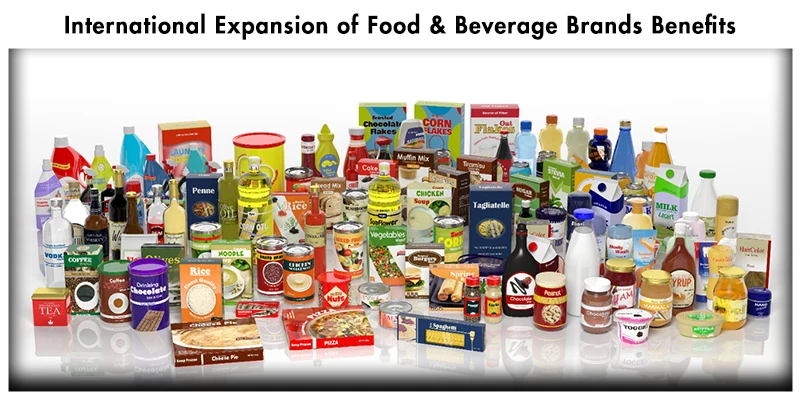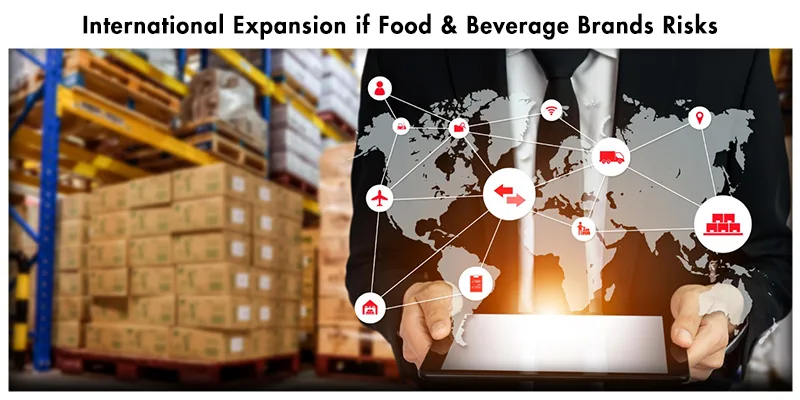Best Ways For International Expansion Of Food & Beverage Brands
Do You Want a Partner Who Can Help With The International Expansion of Your F&B Brand?
Contact Us
The technology helps brands to connect with their international customers on a personal level. Furthermore, there are ‘n’ number of ways to market, introduce, and sell your food and beverage products in a foreign market.
All these things may sound simple and safe, however, it is all an uphill battle. You need to stay dedicated in order to achieve international feat, of course with a well-calculated international market entry strategy.
You might need to fully understand how the international market works or you need to hire an export sales management services for the same. While this may seem as a difficult task, you can rock your foreign entry and also make a name for your brand in the international market with the right strategy. In this blog, we will guide you how to expand your food and beverage brand internationally.
What are the Benefits of international Expansion of Food & Beverage Brands?

International expansion of food & beverage brands is totally beneficial for your business as you try to diversify risk but also invite fresh growth in new prospective markets. Furthermore, setting out a plan to go international will obviously invite infinite growth possibilities.
There’s a lot of fish in the sea, all you need to do is find them and collect them as you travel in foreign seas. If you get in the right strategy your brand might reach the epitome of diversification. You will be open to new data, new segments, and which may lead you to create a perfect brand that is widely known around the globe.
Additionally, you can gain global popularity and create a foodie favorite brand, driving sales, and earning money! When you diversify your business risks like conducting international expansion of food & beverage brands, you will be able to target all season sales. Meaning, you would be selling products in different regions, seasons, etc – flowing the income around the year. Moreover, investing in new markets would reduce the risk of your business getting closed because of a regional calamity, political agenda, etc.
What are The Risks to International Expansion of Food & Beverage Brands?

The first risk to consider when your business is contemplating going international is the possible supply chain complications. As the journeys of your raw materials and products become longer and more complex, the potential for traceability and food safety issues is compounded, and that’s a major liability with the costs of recalls on a global scale significantly higher than those contained within one country.
There’s also the uncertainty of exchange rates, which can fluctuate at any time of day due to factors outside your company’s control. When your assets are crossing borders and customers are paying in foreign currency, your business will be subjected to potentially unfavorable conversions if not timed in accordance with current market conditions, which puts pressure on your staff to constantly be on top of the latest information.
What’s more, customs and compliance laws are different in other parts of the world, so while you might be in the clear with regards to your home nation’s paperwork and regulations, there’s a good chance you may need to take additional measures to satisfy the requirements of another country.
In some instances, that can be costly, but it will always demand additional due diligence on the part of your decision makers. Lastly, there are the more human elements of language and cultural barriers that could prevent your organization from getting the results you’re hoping for in new territories.
If you can’t communicate effectively with your new customers or lack understanding of their customs, your products may be dismissed as mere novelties or misaligned for the types of consumers you’re dealing with.
Build a Strong and Consistent Brand Culture
Regardless of where your business originated from, you’re going to need a strong brand culture that centres around your core values. Because with digital media, borders are a thing of the past. While it used to be up to local markets to develop their own brand strategies, now it’s more important to build a global culture that remains familiar to consumers around the world.
Your messaging is going to seep into other countries no matter how much you try to segment it so your brand should be appropriate across all products and geographical regions. This doesn’t mean that you shouldn’t adapt your culture to suit local markets, but your overall values shouldn’t change as you adapt.
You have to adopt a more unified marketing approach, which involves using a specific style guide to ensure a consistent visual presentation, along with consistent messaging that aligns with your brand values and how you want to position yourself.
This should be involved in every aspect of your business, including the products you provide and how you are marketing and selling them. Your brand culture should permeate into your social media to remind your audience that there is a real group of people behind all these posts that showcase your values and beliefs, showing them that you actually do believe in your company and its purpose.
You can also include blogs to help educate the public about your business and your products, which can allow you to share more about your culture in your branding. It can involve having a powerful story that can be told to highlight your brand values and your business philosophy so that you can properly convince people of your product. This can create a powerful selling point that can easily be adapted to different regions.
Is There a Market For It?
Moving into another country might seem like tapping into a wealth of untapped potential customers, but this isn’t always the case. You might end up facing stiff competition from local brands or even find that there isn’t really a market for your product. Without doing sufficient market research, there is a much lower chance of success for businesses entering new markets. So, before you attempt to expand, you are going to need to do a thorough investigation to identify the needs, competition, target audience and other specific regional requirements. One way you can find out more about your audience and their needs in different markets is by using keyword research. Seeing search volumes for certain keywords can help to gauge the relative interest of certain countries for your products.
Trans Create don’t Translate
You are also going to need to assess how your brand translates, both literally and culturally. It is not about simply copy-pasting your copy into another language, it is about understanding how this audience will perceive your messaging, as a product name that works in your own language could translate poorly into others. For example, the Big Mac from McDonald’s was supposed to be launched as ‘Gros Mec’ in France, which means ‘big pimp’.
Even KFC’s slogan ‘finger-licking good’ was unfortunately translated into Chinese to mean ‘eat your fingers off’. To relate to and connect with your audience, you need to speak their language, which means using the appropriate voice and tone, but also some of the words and phrases that they actually use. While you are not trying to alter your brand values as you adapt to other countries, you will need to adjust your tone and marketing slightly to appeal to the cultural norms of your target customers and ensure that all your product promotions are done in a culturally acceptable way. Understanding how to personalize content for various cultures is integral to ensuring that you are getting the right message across.
Focus On Your Customers
Customers are central to your business—they are what makes the food and beverage industry go round. This is why you should focus on developing a strong relationship with your customers. Constantly ask what are the needs, wants, pain points or desires of your customers all the while positioning yourself as the solution.
Loyal customers are essential for businesses to stay afloat in new markets as expansion is quite an expensive process and it is much easier to retain customers and increase their expenditure than it is to convert new customers. The more they grow to trust you and your brand, the more likely they are to recommend you to a friend or engage with your content.
This requires building a strong customer journey right from the lead nurturing stage and past customer conversions into customer retention. Even though you will be talking to larger and larger audiences as you expand, having content that speaks to all these stages of the customer journey in a personalized manner is key to keeping them engaged with your brand.
This involves ensuring that you are consistently developing the right type of content for segmented audiences, while still being able to adapt your strategy to new trends.
Position Yourself For Success
Turning a food and beverage business global is always going to be a big step for any brand. Success will depend on the level of preparation and planning you do, as well as how well you can understand your various audiences in order to deliver messaging that will actually resonate with them.
How Athena Marketing International Can Help In International Expansion of food & beverage brands?

Athena Marketing International is one of the most innovative and promising food and beverage business consulting agencies. We have helped over 100 brands enter the foreign markets. Also, our established network of more than 20,000 international buyers in 130+ countries will take your business on a smooth runway.
Our export sales management services are designed to meet the expectations of every unique food and beverage manufacturing business. With experience of working with various categories of food and beverage including Coffee, Tea & Beverages, Snack Foods, Nutrition (including Health & Energy Products), Baked Goods, Chocolate & Confectionery, Personal Care & Cleaning Products, Dietary Supplements & Vitamins (including Nutraceuticals), Fruits & Vegetables (including powder, pastes, and extracts), Frozen Foods, Ingredients, Pet Foods, and Specialty (including Gift & Novelty) – AMI is ready to take your food and beverage brand on a whole new different level. If you have a question about our export sales management services, then you can connect with one of our experts for a 30 minutes free consultation video call!
Wrapping Up Words
Now that we’re through explaining each and everything about export sales management for food business. Now it’s your turn to make the right decision! Challenging the international food and beverage market could be a daunting task. However, with the help of Athena Marketing International you can easily pick up the pace, identify target markets, and input customized strategies for faster growth and success!
FAQs
What are the primary challenges faced by F&B brands during international expansion?
- Language and cultural barriers
- Regulatory hurdles and compliance issues
- Supply chain complexities and logistical challenges
- Economic and political risks in foreign markets
- Competition from local and global brands
How can F&B brands effectively identify target markets for international expansion?
- Conduct thorough market research to understand consumer preferences and behaviors
- Analyze economic indicators like GDP, disposable income, and consumer spending patterns
- Assess the competitive landscape and identify potential market gaps
- Consider cultural factors and language barriers to ensure effective brand localization
- Evaluate political and economic stability to mitigate risks
What are the critical steps involved in the international expansion process?
- Conduct market research and due diligence
- Develop a comprehensive international business plan
- Secure necessary permits and licenses
- Establish a robust supply chain and logistics network
- Implement effective marketing and branding strategies
- Build strong partnerships with local distributors and suppliers
- Monitor and adapt to changing market conditions
How can F&B brands maintain product quality and consistency in international markets?
- Establish rigorous quality control standards and procedures
- Implement standardized recipes and cooking techniques
- Select reliable suppliers and partners
- Provide comprehensive training to local staff
- Continuously monitor and improve product quality
What are the key financial considerations for F&B brands during international expansion?
- Initial investment costs for market entry and setup
- Ongoing operational costs, including marketing, distribution, and personnel
- Foreign exchange risks and currency fluctuations
- Potential for higher costs due to import duties and taxes
- Return on investment (ROI) analysis and financial projections

